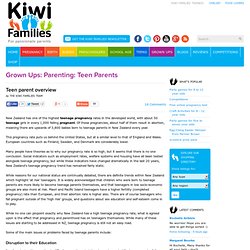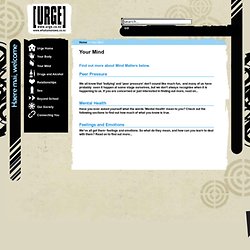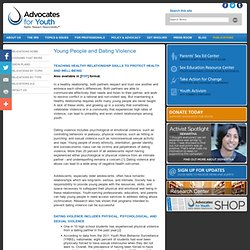

Teen parent overview. New Zealand has one of the highest teenage pregnancy rates in the developed world, with about 50 teenage girls in every 1,000 falling pregnant.

Of these pregnancies, about half of them result in abortion, meaning there are upwards of 3,800 babies born to teenage parents in New Zealand every year. This pregnancy rate puts us behind the United States, but at a similar level to that of England and Wales. European countries such as Finland, Sweden, and Denmark are considerably lower. Many people have theories as to why our pregnancy rate is so high, but it seems that there is no one conclusion. Social indicators such as employment rates, welfare systems and housing have all been tested alongside teenage pregnancy, but while these indicators have changed dramatically in the last 20 years, New Zealand’s teenage pregnancy trend has remained fairly static. Some of the main issues or problems faced by teenage parents include: Disruption to their Education Reduced Earning Potential. Relationship Hassles. Your Mind. Find out more about Mind Matters below.

Peer Pressure We all know that 'bullying' and 'peer pressure' don't sound like much fun, and many of us have probably seen it happen at some stage ourselves, but we don't always recognise when it is happening to us. If you are concerned or just interested in finding out more, read on... Mental Health. Relationships. Relationships- when they're good they're great, when they're bad...well it can be a bit of an emotional roller coaster.

Find out more about how to deal with healthy and unhealthy relationships in this section. Family Family. You've gotta love 'em (most of the time)! Find out more about how to get heard and how to get through the tough times here. Physical and Emotional Abuse Find out what physical and emotional abuse is, and where you can access help. Sexual Orientation Sexual what?! Teenage fertility in New Zealand. Key Statistics - article, September 2003, pp 9-13 Teenage Fertility in New Zealand1 Introduction The rate of teenage childbearing in New Zealand is high by OECD standards.

This has generated considerable interest and discussion among social researchers and policy makers. Teenage childbearing is generally considered a poor life choice. This article presents a brief demographic analysis of recent trends and patterns in teenage fertility in New Zealand. Numbers of births and teenagers The post World War II years witnessed a dramatic trend shift towards early and almost universal marriage, and early childbearing. The proportion of teenage females of marriageable age who were married peaked at 11 percent (11,700) at the 1971 Census. There were over 3,600 adoptions in 1972. Looking at more recent changes in teenage birth numbers, the peak in 1972 was followed by a sharp drop over the next decade – by 1982, births to teenagers had more than halved to less than 4,500. Teens run relationships by mobile. Nearly half of all high school students have started a relationship by text message - while almost a quarter have broken up that way.

That's one of the results from "The Text Generation" - New Zealand's most comprehensive survey on teen cellphone use, released today by NetSafe, the Internet Safety Group. The results, from 1528 teenagers at a decile four Auckland high school will surprise many parents. "(Cellphones) are integral to children's social lives now, in a way that many adults just can't understand," said NetSafe director Liz Butterfield. "It is an essential cultural tool. So you can't assume, even if you haven't bought your child a phone, that they don't have one. " New Zealand's mobile phone market has exploded over the past five years, with text-messaging teens driving much of the growth. Between them, Vodafone and Telecom have more than 3.1 million cellphone customers. Of the 1528 teens surveyed by NetSafe, almost three-quarters used cellphones, with many owning more than one. Healthy & Unhealthy Relationships - Healthy Teen Network
Create a Teen Safety Plan Futures Without Violence has published a Teen Safety Plan aimed at educating teens about their right to their right to a violence free relationship.

The tip sheet provides useful advice to teens, as well as contact information for the National Dating Abuse Hotline. Tips for Teaching Middle School Students Relationship Skills The Dibble Institute published thoughts on most effective ways to reach middle school students with romantic relationship skills programs. Read the tips here. Adolescent Dating Violence Fact Sheet This fact sheet examines programs that prevent dating violence, which can positively change attitudes if they are appropriately implemented and reach all youth, including those most in need.
Adolescent Romantic RelationshipsThis fact sheet from Act for Youth explores adolescent romantic relationships. Dating Violence Among Adolescents. Teaching Healthy Relationship Skills to Protect Health and Well-Being Also available in [PDF] format.

In a healthy relationship, both partners respect and trust one another and embrace each other’s differences. Both partners are able to communicate effectively their needs and listen to their partner, and work to resolve conflict in a rational and non-violent way. But maintaining a healthy relationship requires skills many young people are never taught. A lack of these skills, and growing up in a society that sometimes celebrates violence or in a community that experiences high rates of violence, can lead to unhealthy and even violent relationships among youth. Dating violence includes psychological or emotional violence, such as controlling behaviors or jealousy; physical violence, such as hitting or punching; and sexual violence such as nonconsensual sexual activity and rape. Am I in a Healthy Relationship?